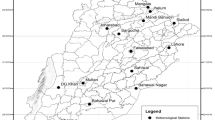Abstract
Most stochastic weather generators have their focus on precipitation because it is the most important variable affecting environmental processes. One of the methods to reproduce the precipitation occurrence time series is to use a Markov process. But, in addition to the simulation of short-term autocorrelations in one station, it is sometimes important to preserve the spatial linear correlations (SLC) between neighboring stations as well. In this research, an extension of one-site Markov models was proposed to preserve the SLC between neighboring stations. Qazvin station was utilized as the reference station and Takestan (TK), Magsal, Nirougah, and Taleghan stations were used as the target stations. The performances of different models were assessed in relation to the simulation of dry and wet spells and short-term dependencies in precipitation time series. The results revealed that in TK station, a Markov model with a first-order spatial model could be selected as the best model, while in the other stations, a model with the order of two or three could be selected. The selected (i.e., best) models were assessed in relation to preserving the SLC between neighboring stations. The results depicted that these models were very capable in preserving the SLC between the reference station and any of the target stations. But, their performances were weaker when the SLC between the other stations were compared. In order to resolve this issue, spatially correlated random numbers were utilized instead of independent random numbers while generating synthetic time series using the Markov models. Although this method slightly reduced the model performances in relation to dry and wet spells and short-term dependencies, the improvements related to the simulation of the SLC between the other stations were substantial.










Similar content being viewed by others
References
Ababaei B (2012) Development and application of a planning support system to assess strategies related to land and water resources for adaptation to climate change (in Farsi). PhD Thesis in Irrigation and Drainage Engineering. University of Tehran, Iran
Ababaei B, Sohrabi TM, Mirzaei F, Karimi B (2010a) Evaluation of a stochastic weather generator in different climates. Comput Inform Sci 3:217–229
Ababaei B, Sohrabi TM, Mirzaei F, Rezaverdinejad V, Karimi B (2010b) Climate change impact on wheat yield and analysis of the related risks: (case study: Esfahan Ruddasht Region) (in Farsi). J Water Soil Sci 2010(3):135–150
Bardossy A, Plate EJ (1992) Space-time model for daily rainfall using atmospheric circulation patterns. Water Resour Res 28:1247–1259
Bogardi I, Matyasovszky I, Bardossy A, Duckstein L (1993) Application of a space-time stochastic model for daily precipitation using atmospheric circulation patterns. J Geophys Res 98(D6):16653–16667
Bras R, Rodriguez-Iturbe I (1976) Rainfall generation: a nonstationary time varying multi-dimensional model. Water Resour Res 12:450–456
Buishand TA (1978) Some remarks on the use of daily rainfall models. J Hydrol 36:295–308
Chin EH (1977) Modelling daily precipitation process with Markov chain. Water Resour Res 13:949–956
Gabriel KR, Neumann J (1962) A Markov chain model for daily rainfall occurrence at Tel Aviv, quarterly. J R Meteorol Soc 88(375):90–95
Green JR (1964) A model for rainfall occurrence. J R Stat Soc Ser B Methodol 26(2):345–353
Hutchinson MF (1995) Stochastic space-time models from ground-based data. Agric For Meteorol 73:237–264
Katz RW (1977) Precipitation as a chaindependent process. J Appl Meteorol 16:671–676
Katz RW, Zheng X (1999) Mixture model for overdispersion of precipitation. J Clim 12:2528–2537
Mehrotra R, Srikanthan R, Sharma A (2006) A comparison of three stochastic multi-site precipitation occurrence generators. J Hydrol 331:280–292
Ng WW, Panu US (2010) Comparisons of traditional and novel stochastic models for the generation of daily precipitation occurrences. J Hydrol Eng 380:222–236
Salas J (1993) Analysis and modeling of hydrologic time series. In: Maidment D (ed) Handbook of hydrology. McGraw-Hill, New York
Sharma A, Lall U (1999) A non-parametric approach for daily rainfall simulation. Math Comput Simul 48:361–371
Stern RD, Coe R (1984) A model fitting analysis of daily rainfall data. J R Stat Soc Ser A 147:1–34
Wilks DS (1989) Conditioning stochastic daily precipitation models on total monthly precipitation. Mon Weather Rev 25:1429–1439
Wilks DS (1998) Multisite generalizations of a daily stochastic precipitation generation model. J Hydrol 210:178–191
Woolhiser DA (1992) Modelling daily precipitation-progress and problems. In: Walden A, Guttorp P (eds) Statistics in the environmental and earth sciences. Edward Arnold, London, pp 71–89
Author information
Authors and Affiliations
Corresponding author
Rights and permissions
About this article
Cite this article
Ababaei, B., Sohrabi, T. & Mirzaei, F. Preserving spatial linear correlations between neighboring stations in simulating daily precipitation using extended Markov models. Theor Appl Climatol 118, 195–202 (2014). https://doi.org/10.1007/s00704-013-1059-x
Received:
Accepted:
Published:
Issue Date:
DOI: https://doi.org/10.1007/s00704-013-1059-x




